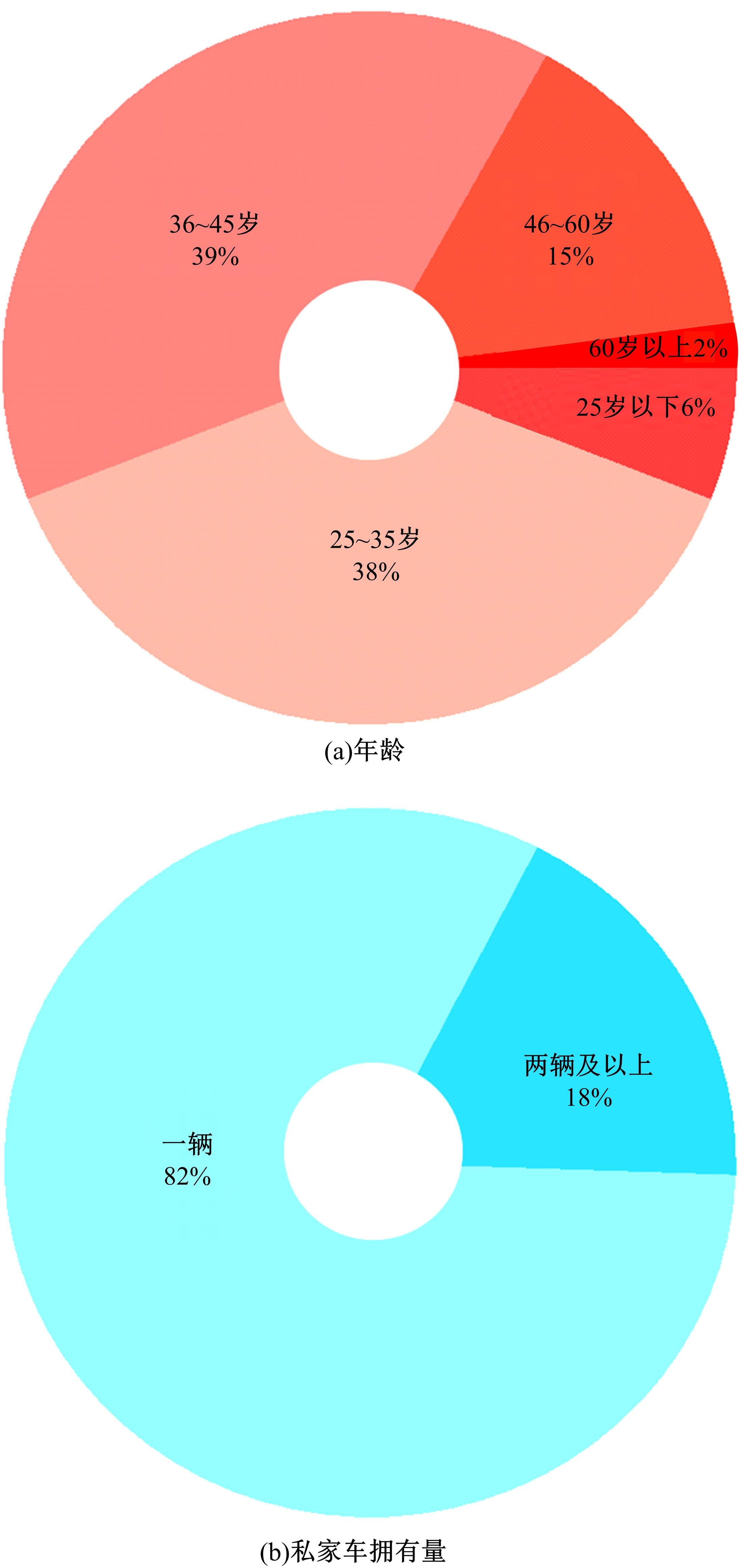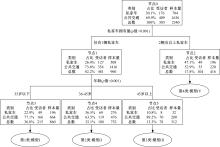吉林大学学报(工学版) ›› 2023, Vol. 53 ›› Issue (7): 1981-1993.doi: 10.13229/j.cnki.jdxbgxb.20211037
• 交通运输工程·土木工程 • 上一篇
限行政策下传统小汽车出行者出行方式选择
- 1.长安大学 运输工程学院,西安 710064
2.山东省交通规划设计院集团有限公司,济南 250031
3.云南省交通科学研究院有限公司,昆明 650011
Travel mode choice of traditional car travelers after implementation of driving restriction policy
Zhuang-lin MA1( ),Shan-shan CUI2,Da-wei HU1,Jin WANG3
),Shan-shan CUI2,Da-wei HU1,Jin WANG3
- 1.College of Transportation Engineering,Chang'an University,Xi'an 710064,China
2.Shandong Provincial Communications Planning and Design Institute Group Co. ,Ltd. ,Jinan 250031,China
3.Yunnan Science Research Institute of Communication Co. ,Ltd. ,Kunming 650011,China
摘要:
以西安市传统小汽车出行者为调查对象,采用行为偏好和意向偏好融合调查方法设计调查问卷,获取特定情景下传统小汽车出行者的出行方式选择行为;采用CHAID决策树方法划分传统小汽车出行者的类别,使用固定参数logit模型和随机参数logit模型构建不同群体限行后的出行方式选择模型,并对比这2个模型的优劣。研究结果表明:传统小汽车出行者分为仅有1辆车的青年出行者、仅有1辆车的壮年出行者、仅有1辆车的中老年出行者和有多辆车的出行者4类;随机参数logit模型的拟合效果更好;仅有1辆车的低收入青年和壮年出行者在限行日更倾向于选择公共交通出行;提高公共交通服务水平有助于吸引仅有1辆车的出行者在限行日选择公共交通方式出行,道路畅通有助于吸引有多辆车的出行者在限行日选择公共交通方式出行。研究结论可以为城市交通管理相关部门制定差异化的限行政策提供理论支撑。
中图分类号:
- U491
| 1 | 国家统计局. 中国统计年鉴[M]. 北京: 中国统计出版社, 2020. |
| 2 | 刘凤喜, 曹弋, 周军. 城市机动车保有量控制及合理使用策略[M]. 北京: 北京交通大学出版社, 2018. |
| 3 | Jia N, Zhang Y, He Z, et al. Commuters' acceptance of and behavior reactions to license plate restriction policy: a case study of Tianjin, China[J]. Transportation Research Part D, 2016, 52: 428-440. |
| 4 | Zhang L L, Long R Y, Chen H. Do car restriction policies effectively promote the development of public transport?[J]. World Development, 2019, 119: 100-110. |
| 5 | Yang J, Lu F, Qin P. How does a driving restriction affect transportation patterns? the medium-run evidence from Beijing[J]. Environment for Development, 2018, 204: 270-281. |
| 6 | Yao W B, Ding Y H, Xu F M, et al. Analysis of cars' commuting behavior under license plate restriction policy: a case study in Hangzhou, China[C].∥The 21st International Conference on Intelligent Transportation Systems. USA: ITSC, 2018. |
| 7 | Huang H J, Fu D Y, Qi W. Effect of driving restrictions on air quality in Lanzhou, China: Analysis integrated with internet data source[J]. Journal of Cleaner Production, 2017, 142: 1013-1020. |
| 8 | Viard V, Fu S. The effect of Beijing's driving restrictions on pollution and economic activity[J]. Journal of Public Economics, 2015, 125: 98-115. |
| 9 | Guerra E, Millard-ball A. Getting around a license-plate ban: behavioral responses to Mexico City's driving restriction[J]. Transportation Research Part D, 2017, 55: 113-126. |
| 10 | Grange L D, Troncoso R. Impacts of vehicle restrictions on urban transport flows: the case of Santiago, Chile[J]. Transport Policy, 2011, 18 (6): 862-869. |
| 11 | Ye J J. Better safe than sorry? evidence from Lanzhou's driving restriction policy [J]. China Economic Review, 2017, 45: 1-21. |
| 12 | Cantillo V, Ortúzar J. Restricting the use of cars by license plate numbers: a misguided urban transport policy[J]. Dyna, 2014, 81(188): 75-82. |
| 13 | Wang L, Xu J, Qin P. Will a driving restriction policy reduce car trips? —the case study of Beijing, China[J]. Transportation Research Part A, 2014, 67: 279-290. |
| 14 | 侯现耀, 陈学武, 王卫杰. 多公交信息下居民出行前方式选择意向分析[J]. 交通运输系统工程与信息, 2014, 14(4): 79-84. |
| Hou Xian-yao, Chen Xue-wu, Wang Wei-jie. Preferences of pre-trip mode choice based on multiple public transit information[J]. Journal of Transportation Systems Engineering and Information Technology, 2014, 14(4): 79-84. | |
| 15 | Böckenholt U, Dillon W R. Some new methods for an old problem: modeling preference changes and competitive market structures in pretest market data[J]. Journal of Marketing Research, 1997, 34(1): 130-142. |
| 16 | Fischer G W, Nagin D. Random versus fixed coefficient quantal choice models[J]. Structural Analysis of Discrete Data with Econometric Applications, 1981: 273-304. |
| 17 | Train K E. Recreation demand models with taste differences over people[J]. Land Economics, 1998, 74(2):230-239. |
| 18 | Liu Y, Hong Z, Liu Y. Do driving restriction policies effectively motivate commuters to use public transportation?[J]. Energy Policy, 2016, 90: 253-261. |
| 19 | 戢晓峰, 刘丁硕, 陈方. 考虑需求强度与群体差异的公路旅客出行行为异质性研究[J]. 北京交通大学学报, 2021, 45(1): 47-61. |
| Ji Xiao-feng, Liu Ding-shuo, Chen Fang. Research on heterogeneity of road passenger travel behavior considering demand intensity and group differences[J]. Journal of Beijing Jiaotong University, 2021, 45(1): 47-61. | |
| 20 | William H G, David A H. A latent class model for discrete choice analysis: contrasts with mixed Logit[J]. Transportation Research Part B, 2003, 37: 681-698. |
| 21 | Zhao W J, Ma Z L, Yang K, et al. Impacts of variable message signs on en-route route choice behavior[J]. Transportation Research Part A, 2020, 139: 335-349. |
| 22 | 赵鹏, 翟茹雪, 宋文波. 考虑个体异质性的高速铁路旅客选择行为[J]. 北京交通大学学报, 2019, 43(2): 117-123. |
| Zhao Peng, Zhai Ru-xue, Song Wen-bo. Passenger choice behavior of high speed railway considering individual heterogeneity[J]. Journal of Beijing Jiaotong University, 2019, 43(2): 117-123. | |
| 23 | Kobayashi D, Takahashi O, Arioka H, et al. A prediction rule for the development of delirium among patients in medical wards: chi-square automatic interaction detector (CHAID) decision tree analysis model[J]. The American Journal of Geriatric Psychiatry, 2013, 21(10): 957-962. |
| 24 | 何凡, 沈毅, 叶众. 卡方自动交互检测法及其应用[J]. 中华预防医学杂志, 2005, 39(2): 133-135. |
| He Fan, Shen Yi, Ye Zhong. Chi-square automatic interactive detection method and its application[J]. Chinese Journal of Preventive Medicine, 2005, 39(2): 133-135. | |
| 25 | 云美萍, 刘广洋, 刘芳. 公交服务质量变化对出行方式选择行为的影响[J]. 中国公路学报, 2017, 30(7): 119-125. |
| Yun Mei-ping, Liu Guang-yang, Liu Fang. Influence of change of public transportation service quality on travel mode choice behavior[J]. China Journal of Highway and Transport, 2017, 30(7): 119-125. | |
| 26 | Rizzi L I, Ortúzar J D. Stated preference in the valuation of interurban road safety[J]. Accident Analysis & Prevention, 2003, 35(1): 9-22. |
| 27 | Ortúzar J D, Willumson L G. Modelling Transport[M]. London:Wiley, 2011. |
| 28 | 钟礼杰, 高玉堂, 金丕焕. Logistic回归模型的拟合优度检验[J]. 中国卫生统计, 1993, 10(3): 55-59. |
| Zhong Li-jie, Gao Yu-tang, Jin Pei-huan. The goodness of fit test of Logistic regression model[J]. Chinese Journal of Health Statistics, 1993, 10(3): 55-59. | |
| 29 | Akaike H T. A new look at the statistical model identification[J]. Automatic Control IEEE Transactions on, 1974, 19(6): 716-723. |
| 30 | Kass R E, Wasserman L. A reference Bayesian test for nested hypotheses and its relationship to the schwarz criterion[J]. Publications of the American Statistical Association, 1995, 90(431): 928-934. |
| [1] | 潘恒彦,王永岗,李德林,陈俊先,宋杰,杨钰泉. 基于交通冲突的长纵坡路段追尾风险评估及预测[J]. 吉林大学学报(工学版), 2023, 53(5): 1355-1363. |
| [2] | 宋灿灿,荆迪菲,谢俊峰,康可心. 设置广告牌的高速公路平曲线路段驾驶行为分析[J]. 吉林大学学报(工学版), 2023, 53(5): 1345-1354. |
| [3] | 卢凯,徐广辉,叶志宏,林永杰. 考虑清空时间的双向队首绿波协调控制数解算法[J]. 吉林大学学报(工学版), 2023, 53(2): 421-429. |
| [4] | 张鑫,张卫华. 快速路合流区主线不同交通状态下的安全性分析[J]. 吉林大学学报(工学版), 2022, 52(6): 1308-1314. |
| [5] | 尹超英,邵春福,黄兆国,王晓全,王晟由. 基于梯度提升决策树的多尺度建成环境对小汽车拥有的影响[J]. 吉林大学学报(工学版), 2022, 52(3): 572-577. |
| [6] | 曲大义,赵梓旭,贾彦峰,王韬,刘琼辉. 基于Lennard-Jones势的车辆跟驰动力学特性及模型[J]. 吉林大学学报(工学版), 2022, 52(11): 2549-2557. |
| [7] | 董春娇,董黛悦,诸葛承祥,甄理. 电动自行车出行特性及骑行决策行为建模[J]. 吉林大学学报(工学版), 2022, 52(11): 2618-2625. |
| [8] | 吴静娴,申华鹏,韩印,杨敏. 考虑城市建成环境非线性作用的通勤时间模型[J]. 吉林大学学报(工学版), 2022, 52(11): 2568-2573. |
| [9] | 马壮林,崔姗姗,胡大伟. 限行政策下城市居民低碳出行意向[J]. 吉林大学学报(工学版), 2022, 52(11): 2607-2617. |
| [10] | 曲大义,黑凯先,郭海兵,贾彦峰,王韬. 车联网环境下车辆换道博弈行为及模型[J]. 吉林大学学报(工学版), 2022, 52(1): 101-109. |
| [11] | 张文会,伊静,刘委,于秋影,王连震. 基于MADYMO的大客车追尾碰撞事故乘员损伤机理[J]. 吉林大学学报(工学版), 2022, 52(1): 118-126. |
| [12] | 孙小雪,钟辉,陈海鹏. 基于决策树分类技术的学生考试成绩统计分析系统[J]. 吉林大学学报(工学版), 2021, 51(5): 1866-1872. |
| [13] | 刘志伟,刘建荣,邓卫. 基于潜在类别的无人驾驶汽车选择行为[J]. 吉林大学学报(工学版), 2021, 51(4): 1261-1268. |
| [14] | 徐进,潘存书,符经厚,刘俊,王郸祁. 典型道路场景以及场景切换时的速度行为特性[J]. 吉林大学学报(工学版), 2021, 51(4): 1331-1341. |
| [15] | 查伟雄,蔡其燕,李剑,严利鑫. 边路车辆出入条件下城市干线信号协调相位差优化[J]. 吉林大学学报(工学版), 2021, 51(2): 565-574. |
|
||



